Independent Supplement on Lockout Makes Amends for Lockout!
It isn’t often we get to praise the Irish Independent but it has just produced an outstanding supplement on 1913 – Get It! Read It! Another one will be out tomorrow!

It isn’t often we get to praise the Irish Independent but it has just produced an outstanding supplement on 1913 – Get It! Read It! Another one will be out tomorrow!
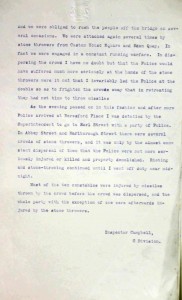
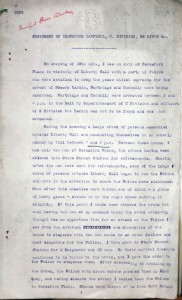 DMP Inspector Campbell’s perspective on the events preceding the Bloody Sunday baton charge give an idea of what the riots looked like from the other side of the Barricades.
DMP Inspector Campbell’s perspective on the events preceding the Bloody Sunday baton charge give an idea of what the riots looked like from the other side of the Barricades.
These documents were provided by John Kennedy of the Department of Arts, Heritage and the Gaeltacht.
1913 – A Policeman’s Lot and Murphy’s Law
Talk given at Garda Historical Society at Store Street Station, August 29th 2013 and Dublin Castle at Police Memorabilia Exhibition, November 16th, 2013
The 1913 Lockout is the Cinderella of Centenaries. It does not fit easily into the dominant nationalist narrative of the independence struggle. While it was retrospectively cast as the opening shot in the struggle for freedom, it can also be regarded as the swansong of British labour in Ireland. In fact the Lockout was only possible because Ireland was part of the United Kingdom. It was the power of the British TUC that sustained the infant Irish Transport and General Workers Union of Jim Larkin and his syndicalist allies who controlled the Dublin Trades Council. (more…)
The Liberty Hall Wrap – one of the commemorative events of the Lockout nobody can miss
There is an interesting new blog on the East Wall For all site on the 1913 Lockout and Irish Citizen Army
In June 1903 the DMP raided a house at 12 Upper Oriel Street. The object of their attention was the resident of the top floor flat, Daniel Courtney, who was running an illegal sheebeen from the premises. Courtney was a Casual Grain Labourer on the Docks and sought to extend his young families precarious income by some extracurricular home brewing. Tried in the Northern Police Court on the 16th June, he was sentenced by Judge Swift to one month’s imprisonment or a £10 fine for “selling porter without a licence.” This was the equivalent of about a month’s wages – a huge sum at the time. Courtney had no choice – he became prisoner No. 110 in Mount joy Jail. A decade later, he was involved in the 1913 Lockout and evicted from his house in East Wall. In 1916 he was an Irish Citizen Army soldier in the Easter Rising, seeing combat at Annesley Bridge, the GPO and present at the surrender in Moore Street. As we mark the centenary of the founding of the Irish Citizen Army , this is his story, as told by Hugo McGuinness.
To read the rest click on http://eastwallforall.ie/?p=
Here are some pictures gleaned from a memoir about Percy Harvey, a bandsman in the Second Battalion of the Royal Dublin Fusiliers.
They are a reminder that soldiers in Britain’s professional army were routinely employed to break strikes in the ‘Great Unrest’ before the First World War. In this case it shows ‘The Toughs’ deployed in Chesterfield, Derbyshire, August 1911 where they fixed bayonets to disperse striking railway men and in the London Docks Strike of summer of 1912. On the latter occasion however the dockers, armed with cudgels, dispersed after some booing and jeers.
It is one of history’s ironies that soldiers, drawn overwhelmingly from the ranks of unskilled and unemployed workers were used regularly in support of the employers.
Our thanks to Tom Burke and Sean Connolly of the Royal Dublin Fusiliers Association for these pictures. Percy Harvey was taken prisoner in August 1914 when the Royal Dublin Fusiliers covered the retreat of the British Expeditionary Force from the initial German advance. He spent the rest of the war as a prisoner of war and returned in 1919 to a Dublin drastically changed.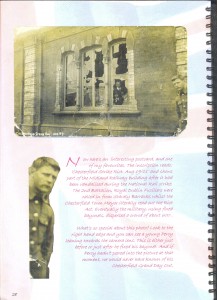
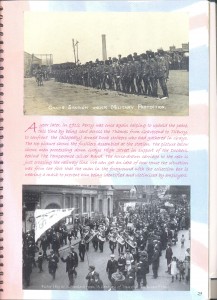
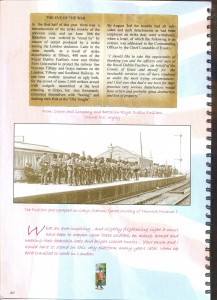
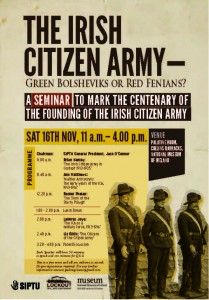
East Wall, Easter Week Rising 1916, History, history week 2013,Writing/Arts/Poetry/Theatre
by EWALL4ALL
This month marks the centenary of the founding of the Irish Citizen Army during the 1913 Lockout. Since August the Dublin workers had been at war with the Dublin Employers Federation which had set out to destroy the Irish Transport and General Workers Union (ITGWU). They had locked out thousands of men and were trying to starve them and their families into submission. The employers had the full use of the military and the police against the workers, and violence and brutality were common place – two men had already been battened to death and many more injured. Also, many strike breakers, including ‘free labourers’ brought in from England, were permitted to carry revolvers. In response, the Irish Citizen Army was founded as a defence force for the workers. James Larkin, James Connolly, Francis Sheehy Skeffington (the well known pacifist) and Captain Jack White (who abandoned his staunch Unionist family background) were amongst the well known figures that would play leading roles.
For more go to:
Here is personal message from Kieran O’Malley a member of James Byrne’s family appealing for people to support commemorative event next Sunday, November 10th
As there is another James Byrne Commemoration in Deans Grange next Sunday, November 10th, we thought it would be a good idea to provide link to Pat Burke’s song on Dun Laoghaire’s forgotten labout hero
https://www.youtube.com/watch?v=RcZx2yv04aE
Also, to correct earlier announcement. This Sunday’s event starts at 12 noon at Dean’s GrangeCemetery, not 2 pm
There was a Commemoration organised by the Men’s Shed Movement in Loughlinstown to mark the Centenary of the death of Irish Transport and General Workers Union branch secretary James Byrne during the 1913 Lockout at Deans Grange Cemetery, County Dublin last Sunday. It was addressed by John Douglas, President of the Irish Congress of Trade Unions. Another commemoration will take place at the same time 12 noon, next Sunday, organised by local the Trades Union activists.
Byrne was a coal heaver by trade who was made ITGWU branch secretary by Jim Larkin. He built a very effective local organisation and was the first trade union official to be arrested in the Lockout, serving a week in Mountjoy for ‘jostling’ a tram inspector. In October 1913 he was charged with intimidating strike breakers. Claiming to be framed he refused bail and went on hunger and thirst in protest at his arrest. He died of pneumonia six days later.
Over three thousand workers attended his funeral where the oration was given by James Connolly, who declared that Byrne had been ‘murdered as surely as any one of those who had suffered for the sacred cause of liberty’.
Here are some illustrations – old and new – regarding this Lockout martyr who as forgotten for so long.
James Byrne prison record from period of first incarceration in August 1913
Here are some photographs from last Sunday’s event and we hope to post more from Sunday’s event as well.
Normally the sponsors name appears on the Dublin Marathon Medal but this year it is Big Jim Larkin to mark the Dublin Lockout. Our thanks to Paul Maher for sending us a photo of his own medal. He did the race in 3.29. Thanks and Well done! These could quickly become collectors’ items
STAILC 1913
An Esras Films Production for TG4
Directed by BRIAN GRAY
To be broadcast on TG4: 30.10.2013 at 21.30
On the occasion of the Centenary Year, Des Geraghty explores the dramatic events that unfolded during the 1913 Lockout in a major TG4 documentary. With original artwork in the form of a graphic novel, music and dramatic reconstruction, this creative and multifaceted documentary unpicks the threads of this monumental strike, examining the social, economic and political concerns of the time.
The 1913 Lockout led to violent class conflict on the streets of Dublin with social and political reverberations that can be felt to this day. The documentary film has an impassioned and credible guide; Des Geraghty is a former President of SIPTU, lifelong Trade Unionist and noted author on Dublin Folk history. Des re-examines the events and experiences of this unique Irish conflict, providing a tangible and direct link to the past through a dynamic use of archive and contemporary locations. Newsreel archive from the period has been unearthed for this production showing Liberty Hall as the nerve centre of the Lockout. Des Geraghty re-discovers the sites of conflict and engages with first hand testimony and speeches of the key players delivered by actors in period costume in-situ.